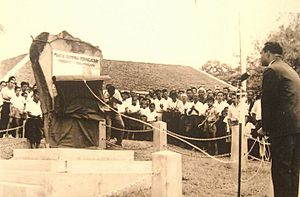Sedomon Gunsanad Kina facts for kids
Quick facts for kids
O.K.K Datuk Seri Panglima
Sedomon Gunsanad Kina
MBE SPDK
|
|
|---|---|
 |
|
| Born |
Sedomon Gunsanad Kina
1894 Kampung Bandukan, Keningau, North Borneo
|
| Died | 8 March 1966 (aged 71–72) Kampung Bandukan, Keningau, Sabah
|
| Resting place | Bingkor, Keningau, Sabah |
| Political party | UNKO (1961-1962) Pasok-Momogun (1962-1964) UPKO (1964-1966) |
| Spouse(s) | Janibah Santul Rose Duaya Jaliah Amat Salmah |
| Family | Gunsanad Kina (father) G.S. Sundang (brother) Tun Ahmad Koroh (nephew) |
Sedomon Gunsanad Kina (1894-1966) was an important leader from Keningau, North Borneo. He was a native chief and later became a politician in Malaysia. He was the son of Gunsanad Kina and the older brother of G.S. Sundang.
Sedomon took over from his father as a leader in Sabah's interior. He was a district chief from 1936 until he passed away in 1966. As a chief, he helped settle disagreements and legal issues among people. He also set up a special center in Bingkor for local administration before World War II. His large home, the Rumah Besar, was very grand. It was even used as the Japanese military headquarters during World War II.
In 1962, Sedomon started the United National Pasok Momogon Organisation. He led this party with his brother Sundang. "Pasok Momogon" means "people of the country." This party was very strong in the interior areas of Sabah. Sedomon was also a successful businessman. He traded farm products like rubber, rice, cinnamon, and tobacco. He also traded animals like horses, pigs, and cows. He received the title Johan Mangku Negara and was made a member of the Order of the British Empire.
Contents
Early Life and Leadership Role
Sedomon was given the special title of Orang Kaya-kaya (O.K.K). He received this title after his father, who was the main chief of the interior of North Borneo, passed away. Sedomon served as O.K.K. from 1936 until he died in 1966.
He gained experience in leadership while working in Bingkor. He worked under D.J. Jardine, who was the governor of the British North Borneo Chartered Company.
In 1936, O.K.K. Sedomon led an alliance of villages in Bingkor. He had the power to manage the Centre of Indigenous Administration in Bingkor. As a district chief, Sedomon helped solve problems among villagers in Keningau. He did this peacefully, following the local traditional laws.
Keningau Oath Stone Ideas
The Batu Sumpah Keningau has important messages carved on it. These carvings partly show Sedomon's ideas for the community.
Making Kaamatan a Holiday
As the main chief of the interior, Sedomon asked the British for a three-day festival. This festival later became known as Kaamatan. Sedomon was from the Dusun and Murut tribes. He wanted Kaamatan to be a holiday for all native people in Sabah. However, the British only agreed when Donald Stephens also made the same request.
Role in Malaysia's Formation
Sedomon and his younger brother played a big part in the movement against forming Malaysia. They started the United Pasok Momogun Party (UPMP). This party broke away from the United National Kadazan Organisation (UNKO). They protested UNKO's choice to support Malaysia's formation.
One reason for their protest was how two different tribes, the Dusun and Murut, were grouped together. They were put under a single name, 'Kadazan'. The UPMP party was officially registered in January 1962. Even though it had members from many different groups, its influence was mostly in areas like Keningau and Tenom.
Views on Malaysia Agreement
The UPMP opposed the formation of Malaysia. However, they did not strongly protest against the British or Malayan governments. Some people thought UPMP was just trying to challenge UNKO for power. But UPMP kept its anti-Malaysia stance during the Cobbold Commission in 1962.
Sedomon's ideas were included in the 20-point agreement. This agreement was given to the Lansdowne Committee in August 1962. His ideas covered important topics like freedom of religion and immigration. They also included issues about land, forests, and local government. Sedomon also shared his ideas with Tun Abdul Razak. This meeting happened at the Rumah Besar mansion. Tun Razak understood Sedomon's requests. He even noted that "If that is the case, people from the Peninsula would require a passport to enter Sabah."
The UPMP's resistance began to weaken. This was due to disagreements within the party and less influence. Only 200 party members attended their convention in September 1962. G.S. Sundang, along with Ong Kee Hui and A.M. Azahari, sent a petition to the United Nations. This petition opposed Malaysia's formation. However, it had no effect and was later withdrawn by Sundang.
In November 1962, the North Borneo group went on a two-week trip to Malaya. At the start of the trip, Sedomon said it was important to understand Malaysia. He noted that many party members did not understand it and were still unsure. He was very impressed by the rural development projects he saw there.
Awards and Honours
Sedomon Gunsanad Kina received several important awards for his contributions.
Malaysian Honours
In 2016, Sedomon was given Sabah's highest award after his death. This award is the Seri Panglima Darjah Kinabalu (SPDK). It comes with the title "Datuk Seri Panglima."
 Sabah :
Sabah :
Foreign Honours
Sedomon was recognized for his achievements in British North Borneo. Queen Elizabeth II awarded him the MBE. This happened on June 9, 1961.
 United Kingdom :
United Kingdom :
 Member of the Most Excellent Order of the British Empire (MBE) – (1961)
Member of the Most Excellent Order of the British Empire (MBE) – (1961)


